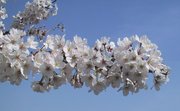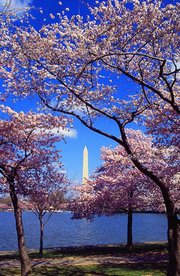Sakura
|
|
- This article is about cherry blossoms and their cultural significance to the Japanese; for other meanings, see Sakura (disambiguation).
Sakura (桜, 櫻) is the Japanese name for ornamental cherry trees and their blossoms. Cherry fruit (known as sakuranbo) come from a different species of tree.
Sakura, a well-known and ubiquitous symbol of Japan, are represented on all manner of consumer goods, including kimono, stationery, and dishware. Cherry blossoms are an enduring metaphor for the ephemeral nature of life, and as such are frequently depicted in art and are associated with both samurai and kamikaze. There is at least one popular folk song--originally meant for the shakuhachi (bamboo flute)--titled sakura, as well as a number of pop songs.
Japan's most beloved variety is the Somei Yoshino. Its flowers are nearly pure white, tinged with the palest pink, especially near the stem. The flowers bloom, and usually fall (or "scatter," 散る, in Japanese) within a week, before the leaves come out. Therefore, the trees look nearly white from top to bottom. The variety takes its name from the village of Somei (now part of Toshima in Tokyo). It was developed in the mid- to late-19th century at the end of the Edo period and the beginning of the Meiji period. The Somei Yoshino is so widely associated with cherry blossoms that jidaigeki and other works of fiction often depict the variety in the Edo period or earlier; such depictions are anachronisms.
Other categories include yamazakura, yaezakura, and shidarezakura. The yaezakura have large flowers, thick with rich pink petals. The shidarezakura, or weeping cherry, has branches that fall like those of a weeping willow, bearing cascades of pink flowers.
SomeiYoshinoBlossomsBark3881.jpg
Annually, the Japanese track the sakura zensen, or Cherry-Blossom Front. Nightly forecasts follow the weather segment of news programs. The blossoming begins in Okinawa in February, and typically reaches Kyoto and Tokyo at the end of March or the beginning of April. Then it proceeds north, arriving in Hokkaido a few weeks later. Japanese pay close attention to these forcasts. They will go to parks, shrines and temples with family and friends and hold a 'flower viewing party' known as hanami (花見). Hanami festivals celebrate the beauty of sakura, and for many, it is an chance to relax and enjoy the beautiful view.
Most Japanese schools and public buildings have sakura trees outside of them. Since the fiscal and school year both begin in April, in many parts of Honshu, the first day of work or school will coincide with the cherry blossom season.
Japan gave 3,000 sakura as a gift to the United States in 1912 to celebrate the nations' then growing friendship. These trees have since lined the shore of the Tidal Basin in Washington, DC (see West Potomac Park), and the gift was renewed with another 3,800 trees in 1956. The sakura trees continue to be a popular tourist attraction (and the subject of the annual National Cherry Blossom Festival) when they reach full bloom in early spring.
During the Second World War, the Sakura served as a motivating symbol for the Japanese people. Japanese pilots would paint them on the sides of their planes before embarking on a Kamikazi mission. A cherry blossom painted on the sides of the bomber symbolized the beauty and ephemerality of nature. (http://www.randomhouse.ca/catalog/display.pperl?isbn=9780676975123) The government encouraged the people to believe that the souls of downed warriors were reincarnated in the blossoms.
See also
- Prunus
- Kigo: discussion of the role of sakura in Japanese poetryfr:Sakura


